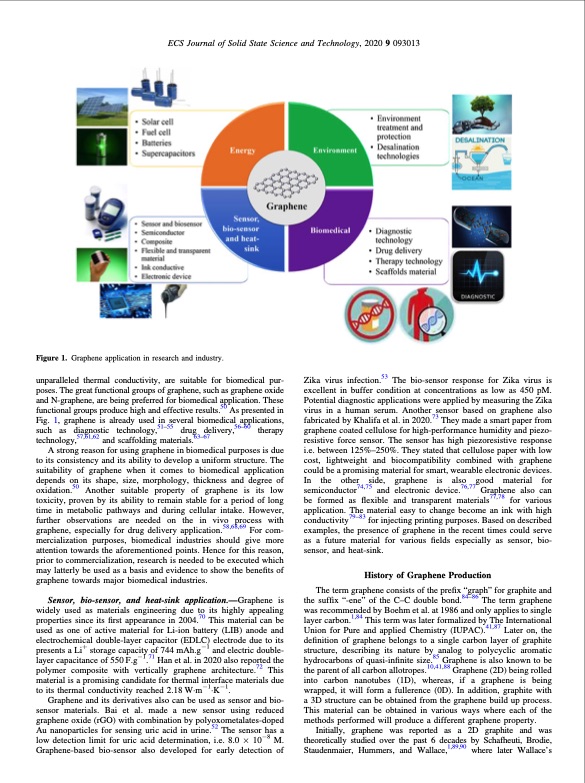
PDF Publication Title:
Text from PDF Page: 003
ECS Journal of Solid State Science and Technology, 2020 9 093013 Figure 1. Graphene application in research and industry. unparalleled thermal conductivity, are suitable for biomedical pur- poses. The great functional groups of graphene, such as graphene oxide and N-graphene, are being preferred for biomedical application. These functional groups produce high and effective results.50 As presented in Fig. 1, graphene is already used in several biomedical applications, such as diagnostic technology,51–55 drug delivery,56–60 therapy technology,57,61,62 and scaffolding materials.63–67 A strong reason for using graphene in biomedical purposes is due to its consistency and its ability to develop a uniform structure. The suitability of graphene when it comes to biomedical application depends on its shape, size, morphology, thickness and degree of oxidation.50 Another suitable property of graphene is its low toxicity, proven by its ability to remain stable for a period of long time in metabolic pathways and during cellular intake. However, further observations are needed on the in vivo process with graphene, especially for drug delivery application.58,68,69 For com- mercialization purposes, biomedical industries should give more attention towards the aforementioned points. Hence for this reason, prior to commercialization, research is needed to be executed which may latterly be used as a basis and evidence to show the benefits of graphene towards major biomedical industries. Sensor, bio-sensor, and heat-sink application.—Graphene is widely used as materials engineering due to its highly appealing properties since its first appearance in 2004.70 This material can be used as one of active material for Li-ion battery (LIB) anode and electrochemical double-layer capacitor (EDLC) electrode due to its presents a Li+ storage capacity of 744 mAh.g−1 and electric double- layer capacitance of 550 F.g−1.71 Han et al. in 2020 also reported the polymer composite with vertically graphene architecture.72 This material is a promising candidate for thermal interface materials due to its thermal conductivity reached 2.18 W·m−1·K−1. Graphene and its derivatives also can be used as sensor and bio- sensor materials. Bai et al. made a new sensor using reduced graphene oxide (rGO) with combination by polyoxometalates-doped Au nanoparticles for sensing uric acid in urine.52 The sensor has a low detection limit for uric acid determination, i.e. 8.0 × 10−8 M. Graphene-based bio-sensor also developed for early detection of Zika virus infection.53 The bio-sensor response for Zika virus is excellent in buffer condition at concentrations as low as 450 pM. Potential diagnostic applications were applied by measuring the Zika virus in a human serum. Another sensor based on graphene also fabricated by Khalifa et al. in 2020.73 They made a smart paper from graphene coated cellulose for high-performance humidity and piezo- resistive force sensor. The sensor has high piezoresistive response i.e. between 125%–250%. They stated that cellulose paper with low cost, lightweight and biocompatibility combined with graphene could be a promising material for smart, wearable electronic devices. In the other side, graphene is also good material for semiconductor74,75 and electronic device.76,77 Graphene also can be formed as flexible and transparent materials77,78 for various application. The material easy to change become an ink with high conductivity79–83 for injecting printing purposes. Based on described examples, the presence of graphene in the recent times could serve as a future material for various fields especially as sensor, bio- sensor, and heat-sink. History of Graphene Production The term graphene consists of the prefix “graph” for graphite and the suffix “-ene” of the C–C double bond.84–86 The term graphene was recommended by Boehm et al. at 1986 and only applies to single layer carbon.1,84 This term was later formalized by The International Union for Pure and applied Chemistry (IUPAC).41,87 Later on, the definition of graphene belongs to a single carbon layer of graphite structure, describing its nature by analog to polycyclic aromatic hydrocarbons of quasi-infinite size.85 Graphene is also known to be the parent of all carbon allotropes.10,41,88 Graphene (2D) being rolled into carbon nanotubes (1D), whereas, if a graphene is being wrapped, it will form a fullerence (0D). In addition, graphite with a 3D structure can be obtained from the graphene build up process. This material can be obtained in various ways where each of the methods performed will produce a different graphene property. Initially, graphene was reported as a 2D graphite and was theoretically studied over the past 6 decades by Schafheuti, Brodie, Staudenmaier, Hummers, and Wallace,1,89,90 where later Wallace’sPDF Image | Progress in Graphene Synthesis

PDF Search Title:
Progress in Graphene SynthesisOriginal File Name Searched:
Progress-in-Graphene-Synthesis-and-its-Application.pdfDIY PDF Search: Google It | Yahoo | Bing
Salgenx Redox Flow Battery Technology: Power up your energy storage game with Salgenx Salt Water Battery. With its advanced technology, the flow battery provides reliable, scalable, and sustainable energy storage for utility-scale projects. Upgrade to a Salgenx flow battery today and take control of your energy future.
| CONTACT TEL: 608-238-6001 Email: greg@infinityturbine.com | RSS | AMP |